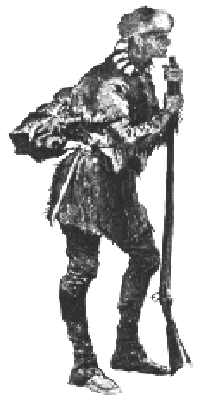|
|
| Camden |

James Broyhill probably looked very
much like
this frontiersman painted by
Frederick Remington. With coonskin cap, buckskin jacket,
breeches and boots,
he was an entirely different breed of man from the powder
wigged Englishman
of the tidewater colonies. |
During 1778, it seemed as if the American Revolutionary War had
come to a standstill. Earlier attempts to conquer the northern
colonies had resulted in such sound defeats and heavy casualties
that the British were ordered to make no offensive land
operations into the interior, but were instead to raid seaports,
burning ships and villages. The British used New York as a
center of operations. The city contained thousands of Redcoats
and its harbor was filled with English ships. General Washington
did not have a navy and was unable to stop the naval attacks and
did not have an army powerful enough to storm the city. This was
frustrating to both sides, but the British broke the deadlock by
shifting the offensive to the southern colonies.
In
December of 1778, British forces captured Savannah, and then went on
to occupy most of Georgia. The offensive was climaxed by the capture
of Charleston on May 12, 1780. The British Commander, General Lord
Cornwallis, planned to follow up the victory with a complete
conquest of the Carolinas. Charleston merchants resumed trade with
England, the former royal governor took over, and to all appearances
the Palmetto State was back in the British Empire. General
Washington responded by sending the seasoned Maryland and Delaware
line regiments southward under General DeKalb. The
colonists perceived the Southern Offensive as a prelude to an
invasion of North Carolina and Virginia. Both colonies quickly began
forming militia units to curb the
coming attacks. Among these was the Virginia Militia
unit formed by Captain Paul Waddleton of Halifax County, Virginia. James
said he enlisted in the unit in the Spring of 1980 and that he believed
that there was a lieutenant named Irwin and a Captain Fountain, both
from Halifax. |
|
| His unit marched to
Hillsboro, North Carolina, where it was put under the command of General
Stephens. James said that they spent about two months there. History is
filled with stories of enthusiastic young men anxious to go to war and
apparently those of James' unit were no exception. He tells us that they
called their companies "the Honest First," "the Black
Guard Second," "the Bloody Third," and "the Lousy
Fourth." His company was attached to the first regiment and he
thought his Colonel's name was Holt Richardson; the adjutant was Samuel
Cobbs; and his company commander was Captain Fountain. |
The troops from Maryland and
Delaware endured incredible hardships. The states they passed through
failed to provide food and other supplies and half starved soldiers
gorged on peaches, green corn, and raw beef. When they arrived in
Hillsboro on June 22, 1780, virtually every unit was plagued by
widespread dysentery.
When news of Charleston's fall
reached Congress it appointed Horatio Gates, the politician's favorite
general to command the Southern Department, over DeKalb's head and
against Washington's advice. Gates, when he took command at Hillsboro
decided to advance on South Carolina. Against everyone's advice, he
insisted on marching the sick men through the most direct route, one
which led through pine forests, where there was no food, instead of
following the longer wagon road, where there were many farms and an
abundant food supply. During this forced march, the soldiers marched
long hours over difficult roads. They were almost always hungry and the
dysentery spread.
On August 16, 1780, the rag tag army confronted
the British at Camden. The West Point
Atlas of Military History shows that the site of the battle was a
three quarter mile strip, flanked on both sides by heavy swamps. Gate's
army was faced south. He placed the Virginia Militia on his left with its
baggage train to the rear, the North Carolina
|

Regular soldier had uniforms, but were
ill equipped to fight a processional army. |
|
Militia in the center,
and the Delaware-Maryland regiments on his left. His total army
contained between 2600 and 3000 men actually fit for duty.
Although Cornwallis had a
smaller force, it consisted primarily of well trained regular soldiers,
which, with their relatively short line of supply, were in good health
and high spirits. And Cornwallis was an outstanding leader beloved by
his men, where Gates was not.
The resulting Battle of
Camden was one of the fiercest fights of the Revolutionary War. The
American militia units panicked at the first bayonet charge; DeKalb,
mortally wounded, held the field with the Maryland and Delaware Line,
which stood its ground. General Gates, witnessing his fleeing militia,
jumped on his racehorse and ran away as quickly as he could, deserting
his unit. He didn't stop until he reached Charlotte, North Carolina,
sixty miles from the battlefield. This battle,- which James referred to
as "Gates Defeat" - finished the general's military career. It
has been called the worst military defeat in American history.
James declared, "I
remember at Hillsboro, General Gates, General DeKalb, Colonel Hovey, and
General Morrison ...Our command immediately broke and retreated in
complete rout until we reached Mast Ferry on the Peedee River."
James did not see the battle as he was with the baggage wagons, possibly
doubled up with intestinal pain, as were many of his comrades.
The green Virginia Militia had been chased away
from its first major battle, and James, along with his fellow soldiers,
returned to Hillsboro, where the unit was disbanded. No formal written
discharges were issued. The soldiers just wandered home, individually
and in small groups.
North Carolina then lay
open to Cornwallis. He marched into it initially hampered only by a few
minor attacks by hastily organized militia units. On October 7, 1780,
one of his armies was completely slaughtered at what is now known as the
Battle of Kings Mountain. |
|